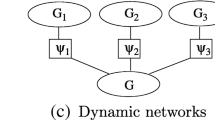Abstract
Networks that change over time, e.g. functional brain networks that change their structure due to processes such as development or aging, are naturally modeled by time-evolving networks. In this paper we present PATENet, a novel method for aligning time-evolving networks. PATENet offers a mathematically-sound approach to aligning time evolving networks. PATENet leverages existing similarity measures for networks with fixed topologies to define well-behaved similarity measures for time evolving networks. We empirically explore the behavior of PATENet through synthetic time evolving networks under a variety of conditions.
Access this chapter
Tax calculation will be finalised at checkout
Purchases are for personal use only
Similar content being viewed by others
Notes
- 1.
Notice that \( \tilde{\chi }:{\mathcal{G}} \times {\mathcal{G}}^{'} \to {\mathbb{R}} \).
- 2.
Notice that \( \tilde{\chi }\left( {G,G} \right) = 1 \) is not required, as the alignment score has no upper bound.
- 3.
Notice that the OSN similarity score measures similarity in the context of the locally aligned segments of the sequences. That is, if OSNs \( {\mathcal{G}} \) and \( {\mathcal{G}}^{'} \) have \( k \) elements aligned with average element-wise similarity of \( h \), whether \( k = min\left( {n,m} \right) \) or \( k < min\left( {n,m} \right) \),
 . Additionally, if OSNs \( {\mathcal{G}} \) and \( {\mathcal{G}}^{'} \) have one element aligned with element-wise similarity of 1.0, while OSNs \( {\mathcal{G}} \) and \( {\mathcal{G}}^{''} \) have four elements aligned with each element-wise similarity being 0.9,
. Additionally, if OSNs \( {\mathcal{G}} \) and \( {\mathcal{G}}^{'} \) have one element aligned with element-wise similarity of 1.0, while OSNs \( {\mathcal{G}} \) and \( {\mathcal{G}}^{''} \) have four elements aligned with each element-wise similarity being 0.9,
 (but \( \tilde{\chi }\left( {{\mathcal{G}},{\mathcal{G}}^{\prime } } \right) < \tilde{\chi }\left( {{\mathcal{G}},{\mathcal{G}}^{\prime \prime } } \right) \)).
(but \( \tilde{\chi }\left( {{\mathcal{G}},{\mathcal{G}}^{\prime } } \right) < \tilde{\chi }\left( {{\mathcal{G}},{\mathcal{G}}^{\prime \prime } } \right) \)).
References
Albert, R., Barabasi, A.L.: Topology of evolving networks: local events and universality. Phys. Rev. Lett. 85(24), 5234–5237 (2000). https://doi.org/10.1103/PhysRevLett.85.5234
Barabasi, A.L., Albert, R.: Emergence of scaling in random networks. Science 286(5439), 509–512 (1999). https://doi.org/10.1126/science.286.5439.509
Bassett, D.S., Sporns, O.: Network neuroscience. Nat. Neurosci. 20(3), 353–364 (2017). https://doi.org/10.1038/nn.4502
Caspi, Y., Irani, M.: Spatio-temporal alignment of sequences. IEEE Trans. Pat. Anal. Mach. Int. 24(11), 1409–1424 (2002). https://doi.org/10.1109/TPAMI.2002.1046148
Dorogovtsev, S.N., Mendes, J.F.F.: Scaling behaviour of developing and decaying networks. Europhys. Lett. 52(1), 33–39 (2000). https://doi.org/10.1209/epl/i2000-00400-0
Elzinga, C.H.: Distance, similarity and sequence comparison. In: Blanchard, P., Bühlmann, F., Gauthier, J.A. (eds.) Advances in Sequence Analysis: Theory, Method, Applications. LCRSP, vol. 2, pp. 51–73. Springer, Cham (2014). https://doi.org/10.1007/978-3-319-04969-4_4
Emmert-Streib, F., Dehmer, M., Shi, Y.: Fifty years of graph matching, network alignment and network comparison. Inf. Sci. 346, 180–197 (2016). https://doi.org/10.1016/j.ins.2016.01.074
Erdos, P., Renyi, A.: On random graphs I. Publ. Math. Debrecen 6, 290–297 (1959)
Holme, P.: Modern temporal network theory: a colloquium. Eur. Phys. J. B 88(9), 234–263 (2015). https://doi.org/10.1140/epjb/e2015-60657-4
Holme, P., Saramki, J.: Temporal networks. Phys. Rep. 519(3), 97–125 (2012). https://doi.org/10.1016/j.physrep.2012.03.001
Kivela, M., Arenas, A., Barthelemy, M., Gleeson, J.P., Moreno, Y., Porter, M.A.: Multilayer networks. J. Complex Netw. 2(3), 203–271 (2014). https://doi.org/10.1093/comnet/cnu016
Koutra, D., Vogelstein, J.T., Faloutsos, C.: DELTACON: a principled massive-graph similarity function. In: Proceedings of the 2013 SIAM International Conference on Data Mining, pp. 162–170. SIAM (2013). https://doi.org/10.1137/1.9781611972832.18
Lee, W.N., Das, A.K.: Local alignment tool for clinical history: temporal semantic search of clinical databases. In: AMIA Annual Symposium Proceedings, pp. 437–441 (2010)
Li, A., Cornelius, S.P., Liu, Y.Y., Wang, L., Barabasi, A.L.: The fundamental advantages of temporal networks. Science 358(6366), 1042–1046 (2017). https://doi.org/10.1126/science.aai7488
Luo, G., Cordier, F., Seo, H.: Spatio-temporal segmentation for the similarity measurement of deforming meshes. Vis. Comput. 32(2), 243–256 (2016). https://doi.org/10.1007/s00371-015-1178-8
Madhyastha, T., Peverill, M., Koh, N., McCabe, C., Flournoy, J., Mills, K., King, K., Pfeifer, J., McLaughlin, K.A.: Current methods and limitations for longitudinal fMRI analysis across development. Dev. Cogn. Neurosci. (2017). https://doi.org/10.1016/j.dcn.2017.11.006
Smith, T.F., Waterman, M.S.: Identification of common molecular subsequences. J. Mol. Biol. 147(1), 195–197 (1981). https://doi.org/10.1016/0022-2836(81)90087-5
Towfic, F., Greenlee, M.H.W., Honavar, V.: Aligning biomolecular networks using modular graph kernels. In: Salzberg, S.L., Warnow, T. (eds.) WABI 2009. LNCS, vol. 5724, pp. 345–361. Springer, Heidelberg (2009). https://doi.org/10.1007/978-3-642-04241-6_29
Acknowledgments
This project was supported in part by the National Center for Advancing Translational Sciences, National Institutes of Health through Grant UL1 TR000127 and TR002014, by the National Science Foundation, through Grant SHF 1518732, the Center for Big Data Analytics and Discovery Informatics at Pennsylvania State University, the Edward Frymoyer Endowed Professorship in Information Sciences and Technology at Pennsylvania State University and the Sudha Murty Distinguished Visiting Chair in Neurocomputing and Data Science funded by the Pratiksha Trust at the Indian Institute of Science [both held by Vasant Honavar]. The content is solely the responsibility of the authors and does not necessarily represent the official views of the sponsors. We thank Sanghack Lee for helpful discussions during the course of this work.
Author information
Authors and Affiliations
Corresponding author
Editor information
Editors and Affiliations
Rights and permissions
Copyright information
© 2018 Springer International Publishing AG, part of Springer Nature
About this paper
Cite this paper
Gur, S., Honavar, V.G. (2018). PATENet: Pairwise Alignment of Time Evolving Networks. In: Perner, P. (eds) Machine Learning and Data Mining in Pattern Recognition. MLDM 2018. Lecture Notes in Computer Science(), vol 10934. Springer, Cham. https://doi.org/10.1007/978-3-319-96136-1_8
Download citation
DOI: https://doi.org/10.1007/978-3-319-96136-1_8
Published:
Publisher Name: Springer, Cham
Print ISBN: 978-3-319-96135-4
Online ISBN: 978-3-319-96136-1
eBook Packages: Computer ScienceComputer Science (R0)





 . Additionally, if OSNs
. Additionally, if OSNs  (but
(but